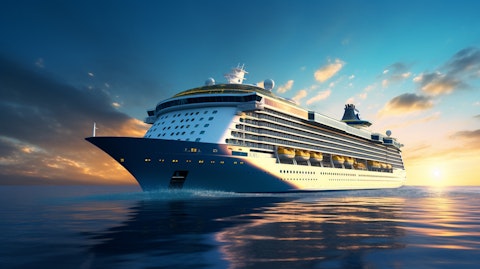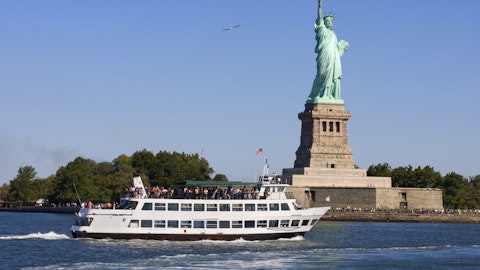Carnival Corporation & plc (NYSE:CCL) Q3 2023 Earnings Call Transcript September 29, 2023
Carnival Corporation & plc beats earnings expectations. Reported EPS is $0.86, expectations were $0.75.
Josh Weinstein: Good morning. This is Josh Weinstein. Welcome to our Third Quarter 2023 Earnings Call. I’m joined today by our Chair, Micky Arison; our Chief Financial Officer, David Bernstein; and our Senior Vice President of Investor Relations, Beth Roberts. Before I begin, please note that some of our remarks on this call will be forward-looking. Therefore, I’ll refer you to the cautionary statement in today’s press release. Another quarter and another set of milestones and records. This quarter, we reached net income well in excess of $1 billion and EBITDA well over $2 billion. We also achieved revenue, adjusted EBITDA and adjusted net income that all exceeded the high-end of our June guidance range with constant currency adjusted cruise costs in line with expectations.
Furthermore, customer deposits and booking volumes, both important forward indicators, hit record levels for the third quarter. Thanks to the efforts of our amazing team, ship and shore, we exceeded the midpoint of our adjusted net income guidance by $175 million this quarter. The outperformance was driven by strength in demand for our brands, with both our North American and European segments equally outperforming expectations. The result was yields that were higher than anticipated that exceeded 2019’s strong levels and that reached an all-time high. On the European front, occupancy came in better than anticipated for Costa and AIDA, with both brands hitting 119% occupancy in August. Not to be outdone, P&O Cruises achieved its highest occupancy in over a decade, despite a 40% capacity increase from 2019.
And as for pricing, our third quarter per diems were 5 points higher than 2019, also hitting record levels and more than overcoming the absence of St. Petersburg, which was among our highest-yielding itineraries and weighted to the third quarter. Normalizing for this impact, we estimate per diem growth would have been up about 7 points, which is consistent with each of the first two quarters and our upwardly revised fourth quarter guidance, which David will elaborate on. Essentially, we’ve consistently been delivering pricing well in excess of 2019 levels, while closing the occupancy gap by 11 points over the course of the year. Continued strength in demand has allowed us to take up our expectations for full-year per diems by a full point. This is a meaningful accomplishment given how much of fiscal 2023 was already behind us.
At the same time, we are working to stay within our narrowed cost guidance range while managing down interest expense as we accelerate our deleveraging plans. The higher revenue alone more than offset the recent spike in fuel prices, which is currently forecasted to step up by 20% heading into our fourth quarter. I would note that while we’ve experienced volatility in fuel prices before, there’s only been one other period in the last 15 years that our fuel price has reached this level. In this case, changes in fuel prices and FX rates combined are a $130 million drag compared to June guidance and masked much of our significant underlying business improvement that is delivering an additional $200 million plus to the bottom line for the second half of the year.
As a result, we still expect our 2023 adjusted EBITDA to be $4.1 billion or more, which is well within our prior guidance range, and we are raising our net income expectations for the year. As I’ve done in the past, to give you a sense of how we are faring operationally without noise from fuel price or currency rates and without the benefit of increased capacity, I’ll share our EBITDA per ALBD progress holding fuel price and currency constant to 2019 levels. We reached 59% of 2019 levels in the first quarter, 73% in the second quarter, 90% in the third quarter, which was better than the 85% we expected, and we are striving to hit 2019 levels in the fourth quarter. Of course, in reality, we are not ignoring the impact fuel is having on our business.
In fact, it’s been a focus for years. We continue to work aggressively to manage fuel costs the best way possible by consuming less. Heading into 2023, we already had the most fuel-efficient fleet of our public peers by a wide margin, and we are looking to widen that gap. We are on track to achieve a step change reduction in fuel usage and resulting carbon intensity in 2023 with fuel consumption per ALBD nearly 16% lower than 2019, even better than the 15% we had anticipated. I know this is stating the obvious, but not only is this effort benefiting our bottom line by hundreds of millions of dollars, it’s also better for the environment and something we’ll keep pushing on for 2024 and beyond. Speaking of 2024, I’m still pleased with our revenue trajectory heading into next year.
Our brands have been working aggressively to build a strong base of business as we position for further revenue yield improvement next year. We are now significantly ahead of same time last year by about 10 points and well ahead of where we were in 2019. In fact, we already have less inventory remaining for sale at the same time last year, despite 5% more capacity and sailing with occupancy at historical levels. Our booked position is as far out as we’ve ever seen it. With our European brands booking curve now essentially back to 2019 levels and our North American brands exceeding historical highs. And importantly, we’ve been able to achieve this 10-point occupancy advantage at higher ticket prices for the same time last year. By all accounts, it’s a great start to 2024.
While we see no signs of demand slowing for our brands, at some point, booking volumes for 2024 will recede as we simply run out of inventory to sell. Now we appreciate there are heightened concerns around the state of the consumer as of late. But the fact is we just haven’t seen it in our bookings or our results, and we believe consumers are continuing to prioritize spending on experiences over material goods. And the vacation value we offer will continue to resonate with those seeking more for their vacation dollar. As you know, we have been leaning into that message given the unprecedented and unwarranted value to land-based vacation alternatives. Further, our revenue base is recurring, with over half our guests being repeat cruisers, is visible with well over 50% of the next 12 months booked at any given time and is predictable with 40% of our onboard revenues now pulled forward by pre-cruise sales, which is an 11-point increase over 2019.
How is all this trending by region? Well, North America consistently remains strong with Carnival Cruise Line, our highest returning brand, continuing to outperform. Accordingly, and due to our portfolio optimization efforts, two-thirds of our capacity growth next year is weighted to Carnival Cruise Line. And while our European brands were on a delayed trajectory for reasons we’ve discussed at length, they are world-class brands in fantastic markets that we are dedicated to for the long-term. So it is incredibly gratifying to see them impressing so nicely and now keeping pace with the improving trends we’ve seen for our North America brand. In fact, in Q3, each of our Continental European brands, AIDA and Costa delivered higher yields than 2019, again overcoming the outsized [indiscernible] they felt from the absence of [indiscernible] of St. Petersburg.
And finally, there’s Australia. I am pleased to say that with the recent lifting of protocols in Australia, like the U.S., they too saw a spike in bookings in response to the great news. Our demand generation efforts are clearly working across all regions. As you can see in our results, our forward guidance, our book position and our booking trends. We are also seeing other positive forward indicators that suggest we are continuing to generate healthy demand. First-time cruisers reached 170% of prior year levels in the third quarter. In fact, we’ve taken well over 2.5 million guests on their very first crews so far this year. Web visits are running at 135% of 2019 levels. Paid search is at 150%, and natural search is at 185%. Suffice it to say, all are consistently running at multiples of our capacity growth.
The effects of our myriad of commercial enhancement activities will compound over time. And our ongoing investments in advertising and lead generation should keep that funnel of demand building. We are also creating excitement around our new ships and new destinations. This quarter, we welcomed our second ultra-luxury expedition ship Seabourn Pursuit. Pursuit marries the same yacht-like small ship experience Seabourn guests have come to expect with an unparalleled range of expedition activities and expert 24 person expedition team and unique features like custom-built submarines. We are looking forward to showing her off later today at her inaugural stop in Miami. And we are about to embark on a drumbeat of news around our new destination in Grand Bahama Celebration Key expected in the second half of 2025.

A luxurious cruise ship sailing the deep blue sea, sun glistening off its decks.
Just yesterday, Carnival Cruise Line announced the opening of hundreds of sailings to Celebration Key ultimately across 18 different ships departing from eight different home ports. You’ll have to stay tuned for more details on this amazing destination and the fantastic experiences our guests can expect. But what I can say today is that not only will Celebration Key deliver Carnival’s patented brands of fund, its strategic location close to so many of our home ports is also designed to advance our fuel and carbon reduction efforts. It’s truly a win-win-win for the environment, for our guests and for our great hosts, the people of the Bahamas. Turning to the balance sheet. We have been actively managing down our debt and reducing interest expense.
With improving performance, positive cash flow and $5.7 billion of liquidity, we anticipate ending the year with debt just under $31 billion, already over $4 billion off the peak and counting. I’ll take the opportunity to remind those naysayers that, as we stated six months ago, this debt reduction happened without issuing incremental equity. That said, we recognize we still have a ways to go to reach investment-grade leverage metric in 2026. The strong demand we are seeing certainly builds confidence in our return to meaningful free cash flow generation and our reduced newbuild pipeline should amplify that opportunity. Once again, I attribute the outperformance this quarter to our greatest asset, our people. Our shipboard team members who are consistently exceeding our guests’ expectations, our shoreside team that supports the ships, generate strong demand and attract new-to-cruise guests along with our travel agent partners, and of course, support from all of you, our investors, our loyal guests and our many other stakeholders.
I think I can speak on behalf of all 160,000 team members when I say that it is a privilege to work at a company whose purpose and mission is to deliver unforgettable happiness to our guests by providing them with extraordinary cruise vacations while honoring the integrity of every ocean we sail, place we visit and life we touch. It motivates us to do our jobs well and responsibly and will help us keep our strong momentum as we head into 2024. With that, I’ll turn the call over to David.
David Bernstein: Thank you, Josh. Before I begin, please note all of my references to ticket prices, net per diems, net yields and adjusted cruise costs without fuel will be in constant currency unless otherwise stated. I’ll start today with a summary of our 2023 third quarter results, then I’ll give some color on our 2023 full-year September guidance. Next, I will provide a recap of our 2024 cumulative advanced book position, along with a few other things to consider for 2024. And then I will finish up describing our financial position. As Josh indicated, our third quarter adjusted net income exceeded the midpoint of our guidance by $175 million as we outperformed our June guidance. The improvement was driven by three things.
First, $90 million of favorability in revenue from higher ticket prices as net per diems were up almost 5%, nearly a point better than the midpoint of our June guidance range, while our brands outperformed on occupancy, achieving 109% for the quarter. In fact, third quarter revenues of $6.9 billion were a record and net yields were once again positive as compared to 2019. Second, we had $40 million of favorability in net interest expense. A successful refinancing gave us the runway to core $1.2 billion of our highest cost debt, and we prepaid an additional $1.1 billion of debt, which reduced interest expense during the quarter. Additionally, we had $900 million of customer deposit reserves returned to the company during the quarter, generating additional interest income and higher overall interest income rate than forecasted also contributed to this favorability.
And third, $45 million of favorability in fuel consumption, depreciation and income taxes drove this final piece. Next, I will give some color on our 2023 full-year September guidance. For the full-year 2023, we now expect the midpoint of our adjusted net loss guidance to be $100 million, an improvement of $75 million versus the midpoint of June guidance, despite the unfavorable net impact of higher fuel prices and currency costing $130 million in the fourth quarter. So our full-year September guidance includes over $200 million of actual and forecasted improvements driven by two things. First, over $150 million of higher revenue for the full-year. On the pricing front, we now expect net per diems to be up approximately 7% for the full-year 2023 compared to a strong 2019, which is 1 point higher than the midpoint of our previous guidance range.
The fourth quarter is expected to build on our third quarter improvement. For the fourth quarter, we now expect net per diems to be up 7% to 8%, resulting in a net yield forecast up over 5%. The improvement in net per diems versus our previous guidance is driven by passenger ticket revenue on both sides of the Atlantic. We do see a continuation of the strong onboard and other revenue trends we have been experiencing given the strength we are seeing in the consumer onboard our ships included in our previous guidance. The third quarter trends were very similar to the first half of 2023, and we are forecasting fourth quarter to be similar as well. And second, $80 million of favorability in net interest expense as the benefits of our deleveraging efforts will continue into the fourth quarter.
Furthermore, we do expect adjusted cruise costs without fuel to be at the high-end of our previous guidance range, but somewhat mitigated by the favorability in fuel consumption, depreciation and income tax expense. Turning to our 2024 cumulative advanced book position. The cumulative advanced book position for the full-year 2024 is well above the high-end of the historical range at higher prices than 2023 levels. This aligns with the company’s yield management strategy to base-load bookings, length in the booking curve and optimize net yields. And now a few things to consider for 2024. We are forecasting a capacity increase of 5% compared to 2023. We are expecting to deliver strong 2024 net yield improvement as compared to 2023 with occupancies forecasted to return to historical levels for the full-year 2024.
We are well positioned to drive 2024 pricing higher with less inventory remaining to sell than the same time last year, despite a capacity increase of 5%. While the occupancy opportunity will drive favorable revenue trends, let’s also remember to model its impact on cost. For example, a 5 to 6 percentage point increase in occupancy could drive adjusted cruise costs without fuel up 1 to 2 percentage points in 2024 as compared to 2023. In addition, in 2024, we are expecting 580 dry dock days, an increase of 18% versus 2023, which will also impact our year-over-year cost comparisons. We expect these cost increases and decelerating inflation, but nevertheless, inflation will be somewhat mitigated by economies of scale from our capacity growth and various cost optimization initiatives.
I will finish up describing our financial position. We are accelerating our debt repayment efforts and aggressively managing down our interest expense. In just six months, we reduced our debt balance by over 10% or nearly $4 billion of the peak from the first quarter 2023. We are in a path to end the year with less than $31 billion of debt, which is over $2.5 billion less than I forecasted six months ago during our March conference call. Our third quarter successful refinancing was priced at the lowest interest rate given to any cruise company in almost two years. This refinancing, which stretched out maturities along with our optimism about our future and the return of customer deposit reserves gave us the confidence to accelerate our debt repayment.
Our maturity towers have been well managed through 2025 with just $2 billion of debt maturities next year and only $2.2 billion in 2025. In addition, because of our actions, our debt portfolio is 80% fixed and our average interest rate is approximately 5.5%. And looking forward, I expect substantial increases in adjusted free cash flow in 2024 and beyond through durable revenue growth to drive down our debt balance on our path back to investment grade. Before I turn the call over to the operator, let me remind you to visit our website for our third quarter earnings press release and presentation. Now operator, let’s open up the call for questions.
See also 30 Most Influential Scientists of All Time and 10 Best ASX Stocks To Invest In.
Q&A Session
Follow Carnival Corp (NYSE:CCL)
Follow Carnival Corp (NYSE:CCL)
Operator: Thank you. [Operator Instructions] Our first question comes from Steve Wieczynski with Stifel. Please proceed.
Steven Wieczynski: Yes. Hey, guys. Good morning. And congrats on the solid quarter and outlook as well. So look, Josh, I know you don’t want to give 2024 guidance yet. And I’m not even sure you’re going to give guidance in December, hold off until March like you did this year. But based on what you’re seeing today, and David did give some color in his prepared remarks around the booking and pricing environment, which both seem very strong into next year. I mean, as we start to think about 2024 from a high-level perspective, is there anything you can kind of help us with in terms of maybe how you’re thinking about those per diems? And look, it sounds like you have a pretty good handle on the pricing side of things at this point. But is the onboard side still present probably the biggest headwind or unknown at this point as you kind of think about the way next year might shape up?
Josh Weinstein: Good morning, Steve. Thanks for the very first call being about 2024 and guidance that we haven’t given. Let me start with what you said about onboard. I think the encouraging thing about onboard is, if you look at what the consumer has been spending with us over the last three quarters and what we projected in the fourth quarter, it hasn’t gone down. So comps might go up and down percentage-wise a bit here and there because of what the world looked like back in 2019 as a percentage quarter-over-quarter. But literally, they’re spending the same amount today that they were three quarters ago. And we haven’t seen that slowdown. So that’s very encouraging, and that’s part of what gives us confidence when we say we’re feeling pretty good about our business in light of whatever is going on in the macro economy.
With respect to our booked business, being 10 points ahead at higher pricing, does give us a good amount of maneuver ability to really deliver on the yields next year, which is what we expect to do. We’re not giving guidance yet, so we’re not going to get into the nuts and bolts, but I’m comfortable that we’re on the right path.
Steven Wieczynski: Okay. Thanks for that. And I know you probably weren’t going to give a very detailed answer there, but I thought I’d try anyway. So if you like that question for 2024, I’m going to try to ask another one and see if I can get something on the other side of the equation, and that’s the cost side, which David, you mentioned – I think you said kind of a 1% to 2% increase in cost for a 5% to 6% increase in load factors. So we just kind of assume you get back into that 106%, 107% range next year, coupled with the pretty material increase in dry dock days, which you guys have communicated before. As we think about next year, I know you’re probably not going to give a detailed answer here either. But should we be thinking about costs kind of up in that low, call it, a 2% to 3% kind of increase next year? Is that too high? Or is that too low? I guess that’s what I’m trying to figure out.
Josh Weinstein: Yes. That’s another good try. How about this. If we think about 2024, what are the tailwinds and what are the headwinds, right? So overall, as we look at 2024, we’ve got a good amount of momentum going, right? First of all, we’re starting from that normalized or elongated booking curve, best book position in our history. The things that we have been doing to try to generate incremental demand and incremental pricing evidentiary says it’s working with 7 points higher per diems pretty much consistently throughout this year as we close the occupancy gap. We expect to be back to full-year occupancy as you were pointing out. The power of our portfolio approach, I don’t want to discount. We’ve been talking about this for many quarters.





